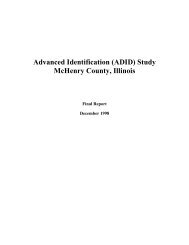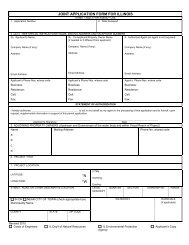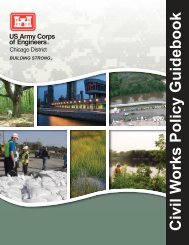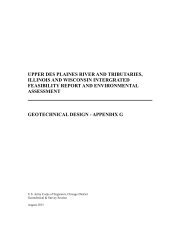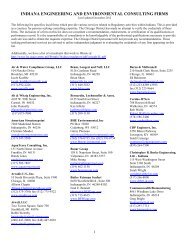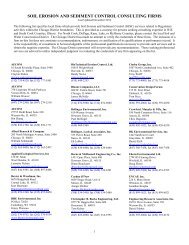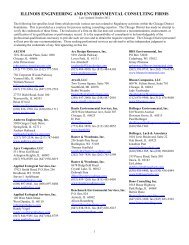Regional Permit Program - Chicago District - U.S. Army
Regional Permit Program - Chicago District - U.S. Army
Regional Permit Program - Chicago District - U.S. Army
You also want an ePaper? Increase the reach of your titles
YUMPU automatically turns print PDFs into web optimized ePapers that Google loves.
d. Authorization under RP8 pursuant to Section 404 of the Clean Water Act is subject to individual waterquality certification under Section 401 of the Clean Water Act when there is a discharge of dredgedand/or fill material to the waters listed below. Return flows from dredging operations to the waterslisted below are considered Section 404 discharges. However, as determined on a case-by-case basis bythe <strong>District</strong>, individual water quality certification may not be required for the installation of outfallstructures in these waters if there will be no more than minimal disturbance to the sediment andsubstrate during construction activities;1) <strong>Chicago</strong> Sanitary and Ship Canal2) Calumet-Sag Channel3) Little Calumet River4) Grand Calumet River5) Calumet River6) <strong>Chicago</strong> River (main stem)7) South Branch of the <strong>Chicago</strong> River (including South Fork)8) North Branch of the <strong>Chicago</strong> River (including East and West Forks and Skokie Lagoons)9) Lake Calumet10) Des Plaines River11) Fox River (including the Fox Chain of Lakes)12) Lake Michigan13) Pettibone Creek14) Kankakee Rivere. For the installation of outfall structures in waters as listed above, there shall be no more than minimaldisturbance to the sediment and substrate during construction activities. The implementation of soilerosion and sediment control measures prior to and during construction is required for any outfallinstallation.f. For a project site adjacent to a conservation area, the permittee shall request a letter from theorganization responsible for management of the area. The response letter should identify recommendedmeasures to protect the area from impacts that may occur as a result of the development. A copy of therequest and any response received from the organization shall be submitted to the <strong>District</strong> with thenotification.g. Stormwater management facilities shall not be constructed in a linear body of water such as a river, orperennial, intermittent or ephemeral stream or creek, unless there is substantial evidence that the projectwill provide a benefit to the aquatic system. Potential benefits could include water qualityimprovements at headwaters of the watershed, or promote wildlife habitat, feeding and breeding areas.h. The project should be designed such that stormwater does not directly discharge into waters of the U.S.All water shall be infiltrated or detained and treated prior to discharging into waters of the U.S. Inaddition, stormwater should be discharged using methods that promote infiltration and water qualitytreatment, such as level spreaders, infiltration trenches and vegetated swales.i. The permittee shall establish and/or enhance an upland buffer of appropriate native plants adjacent to allcreated, restored, enhanced or preserved waters of the U.S., including but not limited to: wetlands,rivers, streams, creeks, ponds and lakes. However, the construction or installation of the support towers,poles, footing, anchors and appurtenant structures for overhead and/or underground utility lines areexempt from this upland buffer requirement.j. No discharge of dredged or fill material may consist of unsuitable material. Material discharged shall befree from toxic pollutants in toxic amounts (see Section 307 of the Clean Water Act). Unsuitable27



